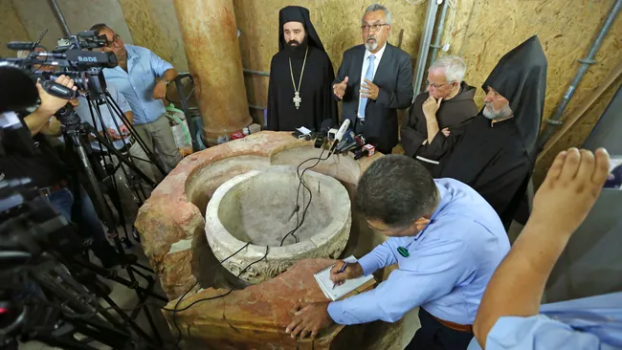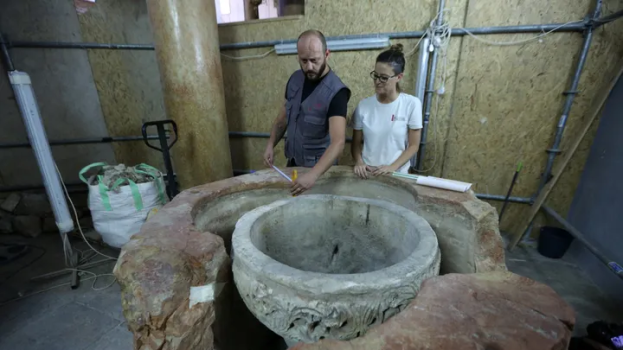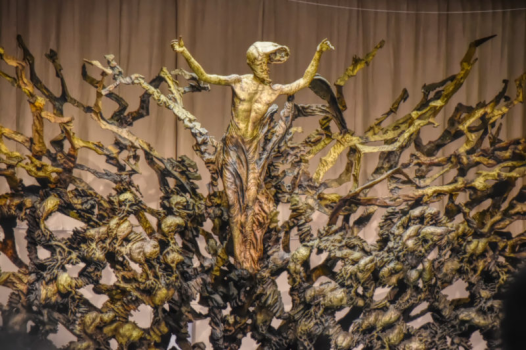The Vatican’s creepy sculpture behind the pope – What you should know
Introduction
Ever heard about the ‘demonic’ idol in the Vatican? Well, this refers to the large modern sculpture depicting the resurrection of Jesus, a backdrop work of art behind the stage in Paul VI Audience Hall.
The Paul VI Audience Halls draws many conspiracy theories not only due to this sculpture that people swear is a demonic representation and a serpent idol, but also because the design of the hall makes many associate it with snake imagery.
The hall is where the pope holds his weekly audiences with believers when the weather is not suitable for outdoor audiences at St. Peter’s Square.
Back to the sculpture, what is it and why do people associate it with serpents and demons?
The Resurrection is a colossal sculpture created by
Pericle Fazzini and measures an impressive 66-ft by 23-ft by 10ft. It depicts Jesus rising from the crater of a nuclear bomb in the Garden of Gethsemane...
...Being situated as it is at the most prominent place in Paul VI Audience Hall is a way to remind the audience that as Christians, they should not fear the second coming of Jesus Christ. Instead, they should be aware that their pilgrimage and faith in this world is a continuous Advent. It lifts them up to reach the definitive encounter with Jesus Christ.
Indeed,
The Resurrection mirrors the fatalistic touch that surrounds all thought of the second coming of Jesus Christ. When Christians think of the Second Coming of Christ, there is something awe-inspiring about this event.
What it shows
Occupying the entire middle section of the wall behind the stage, at its center is the risen Christ, majestically soaring amidst the chaos that tells of death. He has long hair and a beard that both look like they are being moved about by the wind; his face has the look of inner pain.
The chaos is represented through the collection of natural elements fused with each other though they are not well defined. These depict rocks, roots and twigs.
The sculpture’s uncomfortably contorted shapes that depict the chaos from which a rising Christ emerges is fitting of the great event of which it tries to portray.
It looks scary because it is meant to be scary.
After all, rising from a nuclear bomb crater can hardly be considered a calm and passive endeavor.
Inspiration
According to Fazzini, the inspiration to create this artwork was because he pictured the idea of Christ preaching peace for two millennia in the place where he last prayed – the olive grove of Gethsemane. He then conceives the moment of the Resurrection as an explosion from the earth that disrupts the garden as such following in the
New York Times2:
I had the idea of depicting Christ as if He were rising again from the explosion of this large olive grove, peaceful site of His last prayers. Christ rises from this crater torn open by a nuclear bomb; an atrocious explosion, a vortex of violence and energy.
Analysis
When you think of artworks with religious connotations, it makes sense why they would feature themes linked to the condition of mankind. Therefore, the artist often places themselves in the presence of pain and has the desire to have the answers or give the answer to the question of existence, death, resurrection, etc.
Fazzini drew from the nuclear tension-filled landscape of the Cold War era and used it to give meaning to the obscure event that is the resurrection of Christ. The resulting picture is disturbing and problematic.
The sculpture reflects the situation of a secularized and fearful era where the world’s emerging superpowers have it under the threat of a nuclear war of epic apocalyptic proportions. This sculpture thus may cause discomfort among viewers even at the time the fatalistic theme was too close to reality.
While the rising Christ is meant to be a soothing figure for Christians in the face of the chaos, at the time, it must have also induced fear, knowing that the threat of the world ending fatally was very real. It thus assumed a Biblical sense of prophecy frighteningly similar to what is described in the book of Revelations and drawing from the situation that was ongoing in real life.
Though mankind has gone past the state of tension and fear that characterized the Cold War Era, there are many other hopeless and seemingly destructive events and disasters that humans experience.
These form the basis of the chaos from which one can find hope, such as in the case of the rising Christ, emerging from the chaos of destruction and death. As such, while the sculpture may be ominous and inspire discomfort, it is also a reminder of the hope that one gets if they put their faith in Christ.
The artist here plays the role of a protagonist who uses different themes, ideologies, styles and imagery to give hope to those shackled by the violence and fear that characterizes the world.
This sculpture thus is, in essence, a crying defense of mankind by depicting the dawn of the second coming of Christ that even though he goes through agony in emerging from the destruction caused by humans upon themselves, he is ready to show compassion and give hope to the same humans.
This shows the inherent moral strength that Christ possesses and is a reminder that we should try to emulate the same. And since artists are able to reflect the situation at the time of creating their work, it is only natural that Fazzini chose to depict the season at the time just like other artists drew from seasons in real life such as the genocides, war, concentration camps, technological advancements, etc.
These artists do not allow themselves to be gagged and choose to represent real life as they fit, and in this case, Fazzini excelled at it.
read more here









